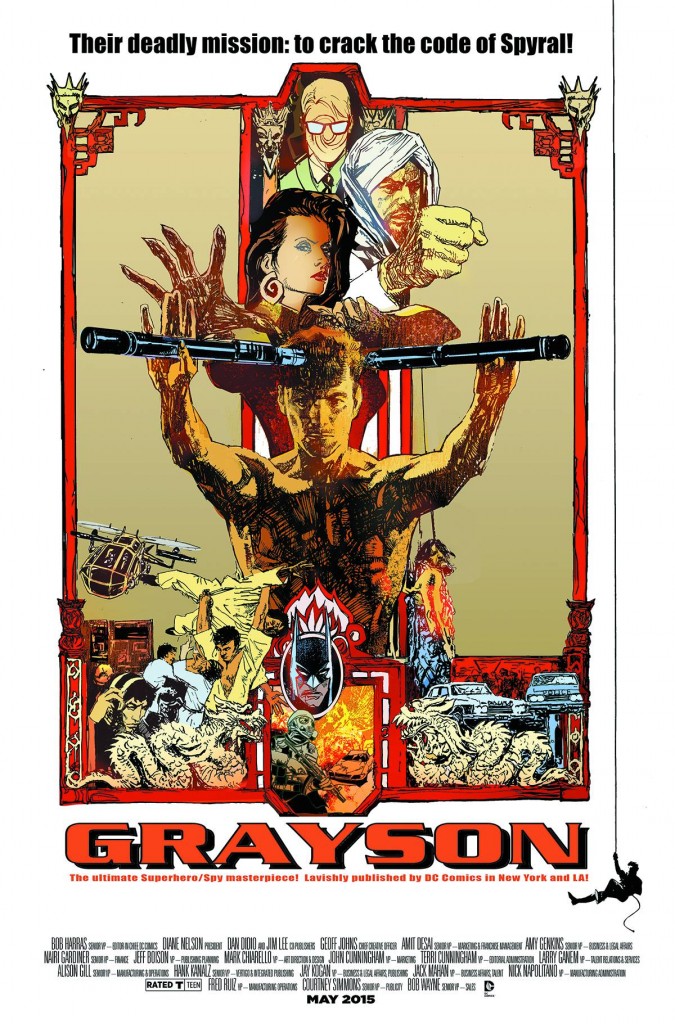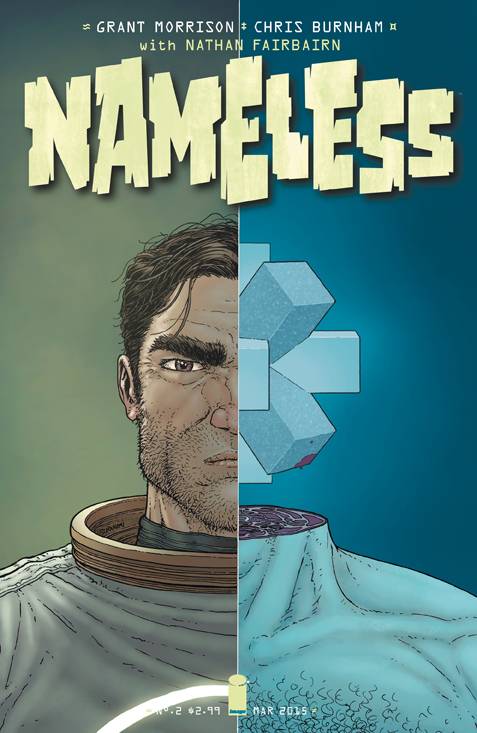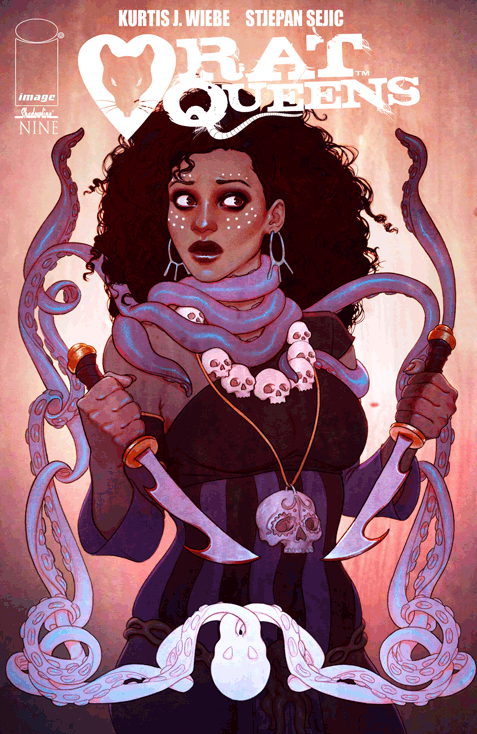By Molly Jane Kremer and Jarrod Jones. Our Week In Review serves to fill in the gaps our frequently verbose comic book coverage leaves behind. Each week, we take a brief look into the books that demand attention.
DC Comics/$2.99
Written by Tom King and Tim Seeley.
Art by Mikel Janin; colors by Jeromy Cox.
JJ: My attitude towards the DC Universe(s) in the last month has been a jumble of excitement and apathy. Ever since the publisher announced that they would yet again dramatically overhaul their entire line after Convergence does whatever the hell its gonna do after the month of May, what little security DC provided its continuity has all but flown out the window. But if I’ve truly loved one thing that’s come from the monstrous havoc that is the New52, it has been Tom King, Tim Seeley, and Mikel Janin’s Grayson. And its latest issue packs one hell of a wallop.
But if Convergence shifts and churns and mixes and deletes all the momentum of the New52 multiverse, what’s there to care about in the events that lead up to it? Aren’t we all just clockwatching at this point? Grayson not only makes it safe to care, it makes caring compulsory.
In a mere eight issues, Grayson has accomplished more world-building and character growth than most books can muster in an entire year. In its breathless brevity King and Seeley’s secret agent melodrama provides us with thrilling entertainment with pathos to burn. It’s easily the most concise book DC has in its lineup, and with issue #8, its narrative has reached critical mass. The entire book is a shocker, but its ending is – for us kids who have been following the Bat-books since the days of Morrison – an absolute stunner. I won’t spoil anything here. Just know that King, Seeley, Janin, and colorist Jeromy Cox have kicked out yet another boffo issue.
A lot of thoughts, guesses, and suspicions are rattling through my dome concerning the state of the DC Universe after Convergence. What does DC have in store for its singular universe after their multiversal mash-up? If what Dan DiDio says is true – that, post-Convergence, “story trumps continuity” – and coupling that statement with the fact that Grayson will continue as a series after all this cosmic hullabaloo, the safe bet is the implications of this issue’s ending mean what I think they mean. Which also means King and Seeley aren’t done with Grayson yet. There simply isn’t a truth more comforting than that.
10 out of 10
Written by Jeff Lemire.
Art by Ramón Pérez; colors by Ian Herring and Ramón Pérez.
MJ: Though it’s ever the critical darling, Matt Fraction and David Aja’s Hawkeye has been languishing in delay-purgatory for over a year, seeing print only six times in 2014. It’s understandable (and expected) that Marvel would want a monthly comic to come out, well, monthly (or close to it), so it’s no surprise that they finally put together a new star-studded team to launch All-New Hawkeye. It is, however, rather odd that after having so much patience for the creative team who started the book (who scored the company a few Eisner Awards for doing it), the publisher decided to release the new series before the final issue of the Fraction/Aja run ever saw print. It’s like only playing seven minutes of an eight minute song before unceremoniously skipping to the next track: You’ve already sat patiently while listening to most of the song (and it’s so goddamn good), so why not let that last chorus line echo through its coda like it’s supposed to?
But, the rudeness of its scheduling aside, All-New Hawkeye #1 is an excellent comic. This is writer Jeff Lemire’s first foray into the House of Ideas (although he’s written for an archer before, y’know, over at the Distinguished Competition? The one who wears green instead of purple?), and he admirably heads in a different direction than what has come before, concentrating a large portion of the issue on a flashback sequence with Clint and his brother Barney as children. Gorgeously illustrated by artist Ramón , these scenes of kiddos catching frogs are sublimely rendered in purpley-blue watercolor washes, evoking the idylls of childhood… before an abusive foster father enters the narrative. The bright, splotchy reds coloring those panels make his appearance all the more jarring and impactful, despite very little visible violence.
The rest of the comic consists of Clint and his very-much-not-a-sidekick Kate Bishop taking down a Hydra base in search of an “unstable” weapon – and these scenes make the lack of transition between the two Hawkeye series all the more frustratingly apparent. (Kate’s back from Cali? Going on missions with Clint? And Clint has Starktech hearing aids? What happened???) But that certainly isn’t the fault of this new creative team, and they do a fine job of making everything as straightforward as they can. The art in these scenes – chock full of punchin’ and kickin’ and shootin’ – has a tinge of Aja’s style without losing Pérez’s flair for expression and action, and Ian Herring’s flat bold colors (aesthetically similar to those of Matt Hollingsworth in the previous series) assist in keeping the art reminiscent of the previous series while still keeping a style all its own.
Lemire keeps the back-and-forth between Clint and Kate as snappy as we’re used to, if a little less irreverently (and pricelessly) goofy, and intersperses the childhood flashbacks with the Hydra mission to great effect – they’re edited together to parallel Clint’s relationship with his big brother Barney alongside his relationship with sorta-kid-sis Kate. Lemire always excels at a narrative focusing on the pathos of young people (see this week’s excellent Descender #1, also penned by him) and this issue is no exception. And while the issue assumes familiarity with the previous series’ main beats, it can still suffice as a jumping-on point for readers new to the characters. All in all, All-New Hawkeye #1 proves that this team is more than worthy of following their esteemed predecessors: And, if they can get an issue out every month…? So much the better.
8.5 out of 10
Image Comics/$2.99
Written by Grant Morrison.
Art by Chris Burnham; colors by Nathan Fairbairn.
JJ: There’s a moment in the second issue of Grant Morrison and Chris Burnham’s Image ick-fest where a character shouts out, “Jesus! It’s like the goddamn Exorcist meets Apollo 13!” It’s an astute statement, especially after chewing on the prophetic words of Nameless himself, who translates some downright spooky jibberish to his incredulous space-mates: Battles in Heaven? “Prepare for wrath?” The fuck?
There’s also a defensive tone to that line. It reads as if Morrison either wants to tamp down any criticism to his latest (and audacious) collaborative stunner, or he seeks to supplant any basic-ass generalizations of it by beating everybody to the punch. It’s a moment that’s worth a palate-cleansing chortle, especially after enduring the book’s blood-smeared, head-decapitating, bowel-loosening zero-gravity carnage. It reminds us all to relax. (Besides, the book feels more like Event Horizon meets Armageddon anyway.)
One thing can be said for Morrison and Burnham’s Nameless: it doesn’t play nice for anybody. It’s crude, baffling, and – in certain places – downright disgusting. (These are positives, people.) Burnham embraces the scuzzier facets to his artistic style; his instantly recognizable pencils and inks provide just enough gross throughout the book, giving Morrison’s nasty narrative that much more blech. In Burnham’s world, hair is always greasy, stubble is invariably scratchy, and skin is constantly oily. With his immersive imagery, you can nearly smell the environments Morrison tasks the artist with rendering (for better or for, um, ew). There’s a nagging itch to hop into a piping-hot shower after taking in a full book of Burnham’s illustrations. (Again. Positives.)
There’s a flipside to all this yuck: Paired with colorist Nathan Fairbairn, Burnham’s gorgeous splash-pages provide a staggering enormity that his work had heretofore never explored. It would be enough to acknowledge that we float with Nameless in the endless ink-blot of space, but through Fairbairn and Burnham’s collaborations, we suffer a disorienting vertigo. When a comic book affects so viscerally, that’s not merely a job well done; that’s a work of art.
9 out of 10
Image Comics/$3.50
Written by Kurtis J. Wiebe.
Art and colors by Stjepan Šejić.
MJ: Rat Queens is yet another critically-acclaimed comic bogged down by major delays; while we’ve received two done-in-one origin issues in the interim, Rat Queens #9 continues from last July’s dangling cliffhanger. Series artist and co-creator Roc Upchurch’s arrest for domestic abuse was a major reason for the many months readers spent languishing without Violet, Hannah, Dee and Betty’s profanity-laced adventures in fantasy-campaigning – a major problem for a book that gained its audience by being ridiculously and refreshingly femme-friendly. (Writer Kurtis J. Wiebe has aptly referred to Rat Queens as Lord of the Rings meets Bridesmaids.) When Stjepan Šejić – already well-known for beautifully rendered fantasy comics with strong female leads – took over the art duties, it seemed like the book was finally getting back on track. And it really does feel like a return to form for the title, in every way possible.
The time between issues does put a damper on the action; I admittedly had to go back and review issue #7 to remind myself exactly what the hell was going on, because this is an action-heavy issue that drops you directly into some intense shit. (I’m sure it will read perfectly well in book form however, without that long wait.) Šejić’s battle scenes are suitably epic, bloody and compelling, the rainstorm backdrop only adding to the thrill of it all. Wiebe’s dialogue remains exceptional as well: It’s smart, funny, and never too heavy on the exposition – and the girls’ conversations are still laugh-out-loud highlights.
There’s not many other places in comics – or fiction in general – to find a storyline based around a group of women and their interactions with each other (or how well they beat the shit out of monsters). It’s easy to find a certain glee in how well Rat Queens subverts genre tropes: There’s even a reverse damsel-in-distress in Sawyer, Hannah’s lover, who’s been trussed up by the villain (and rather, um, exposed) as suitably vulnerable bait. The comic careens flawlessly between humor, drama, action, and back again to humor, always staying on point as a richly-imagined fantasy tale. Rat Queens’ return, and its continuing, blessedly-high level of quality, will be met with both relief and joy by anyone who enjoys reading really good fucking comics.
9 out of 10
Agree? Disagree? What comics did YOU read this week? Let us know in the comments section below.

















